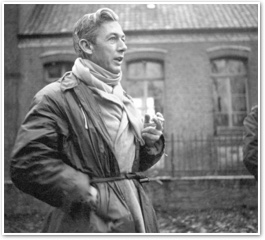Robert Bresson
- HEATHER KING
Robert Bresson's working habits were idiosyncratic and uncompromising.
 Robert Bresson (1901-1999), acclaimed French film-maker, used Catholicism, his early calling as a painter, and his experiences as a prisoner of war to produce such cinematic masterpieces as Diary of a Country Priest, A Man Escaped, and Pickpocket.
Robert Bresson (1901-1999), acclaimed French film-maker, used Catholicism, his early calling as a painter, and his experiences as a prisoner of war to produce such cinematic masterpieces as Diary of a Country Priest, A Man Escaped, and Pickpocket.
Bresson favored stars with no previous on-screen experience, preferring to call his actors "models." He strictly controlled their actions, down to the number of steps and eye movements.
"The things one can express with the hand, with the head, with the shoulders!" he wrote in Notes on Cinematography. "How many useless and encumbering words then disappear."
His working habits were idiosyncratic and uncompromising. He made only thirteen features over the span of forty years.
Loss of innocence, childhood suffering stemming from abusive authority figures, and the seeming absence of God are Bresson's major themes. His films are spare, slow, and allegorical.
Diary of a Country Priest (1951), based on the well-known Georges Bemanos novel, is the tale of a small-town novice priest who fails in almost every particular. Suffering secretly from tuberculosis, and unable to eat anything more than dry bread soaked in wine, he is accused by his parishioners of being a drunk. He tries desperately to help deliver a female parishioner from spiritual peril; the parishioner's young daughter spreads scandalous rumors. And yet, as he lies dying, his last words are "All is grace."
Claude Laydu played the cure and was selected, as was true generally of Bresson's actors, not so much for his theatric ability as for the sensitivity and asceticism of his face.
A Man Escaped (1956), shot almost entirely in a lone prison cell, attains almost unbearable existential and religious tension with the sparing use of voice-over and lingering shots of objects and body parts: a bedspring, a hand, a want.
Claude Laydu played the cure and was selected, as was true generally of Bresson's actors, not so much for his theatric ability as for the sensitivity and asceticism of his face.
Au Hasord Balthazar (1966) features a broken-down donkey, and the abused young girl who cares for him, as Christ figures. In Robert Bresson: A Passion for Film, Tony Pipolo observed that "the action in the prologue is not primarily conveyed through expositional dialogue, but through gesture, look, and action in succession." Critic Daryl Chin observed that, with his Balthazar cinematographer Ghislain Cloquet, "Bresson would evolve a cinematic style of subtle, sun-dappled radiance; without extending the photography into extremes of chiaroscuro contrast, Cloquet would heighten the lighting so that even the grays would glisten."
Mouchette, Bresson's next work with Cloquet, would, like all his previous films, be in black and white. His last five were in color.
Though sometimes described as a "Christian atheist," Bresson observed: "There is the feeling that God is everywhere, and the more I live, the more I see that in nature, in the country. When I see a tree, I see that God exists. I try to catch and to convey the idea that we have a soul and that the soul is in contact with God. That's the first thing I want to get in my films."
 This is Meaghen Gonzalez, Editor of CERC. I hope you appreciated this piece. We curate these articles especially for believers like you.
This is Meaghen Gonzalez, Editor of CERC. I hope you appreciated this piece. We curate these articles especially for believers like you.
Please show your appreciation by making a $3 donation. CERC is entirely reader supported.

Acknowledgement
 Heather King. "Robert Bresson." Magnificat (October, 2017): 99-100.
Heather King. "Robert Bresson." Magnificat (October, 2017): 99-100.
Reprinted with permission from Magnificat.
Join the worldwide Magnificat family by subscribing now: Your prayer life will never be the same!
The Author

 Heather King is a sober alcoholic, an ex-lawyer, a Catholic convert, and a full-time writer. She is the author of: Parched, Redeemed: Stumbling Toward God, Marginal Sanity, and the Peace That Passes All Understanding, Shirt of Flame: A Year with St. Thérèse of Lisieux, Poor Baby, Stripped, Holy Days and Gospel Reflections, and Stumble: Virtue, Vice, and the Space Between. She lives in Los Angeles. Visit her website here.
Heather King is a sober alcoholic, an ex-lawyer, a Catholic convert, and a full-time writer. She is the author of: Parched, Redeemed: Stumbling Toward God, Marginal Sanity, and the Peace That Passes All Understanding, Shirt of Flame: A Year with St. Thérèse of Lisieux, Poor Baby, Stripped, Holy Days and Gospel Reflections, and Stumble: Virtue, Vice, and the Space Between. She lives in Los Angeles. Visit her website here.




